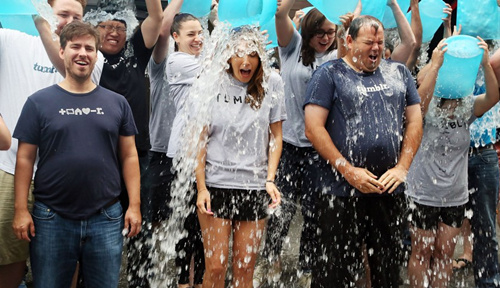- Product Center
- Anbang News
- Industrial & Commercial Ne..
- Warm Knowledge
- News & Notice
- Trace Heating
- New York heavy snow
- The Northeast American hit by heavy snow,the roof electric heat tracing is very effective
- Contact US
-
TEL:
0086-550-2399006FAX:
0086-550-2399018PHONE:
0086-18355088886EMAIL:Dennis@cnheatingmat.com
After-sales service:Afterservice@anbangcn.com
ADDRESS:
No288.Tianye North Road TianChang City,Anhui,China,239354

Ice bucket challenge how to spend over two hundred million?

Ice bucket challenge videos raising money for the ALS Association charity have saturated Facebook news feeds in the last month. It’s easy to participate in the very viral video campaign: film yourself pouring a bucket of ice water over your head, then challenge a friend or frenemy to do the same within 24 hours. At first, the dousing would substitute for sending a check to the ALSA, but many participants now do both. This week former President George W. Bush, actor Ben Affleck, Vogue editor Anna Wintour, and General Electric chief executive Jeff Immelt became the most recent famous faces to get soaked.
At some point the ice bucket campaign will dry up, and photos of your friends’ kids and cats will again dominate your news feed. But the challenges for the ALS Association will just be beginning.
Since July 29, the ice bucket challenge has raised $41.8 million for ALSA, which helps fight amyotrophic lateral sclerosis, a disease that affects nerve cells in the brain and spinal cord commonly referred to as Lou Gehrig’s Disease. That eight-figure sum far surpasses the $2.1 million ALSA raised in the same period last year, and more than doubles the total revenue the organization generated all of last fiscal year ending January 2014—$24 million, according to its most recent 990 tax form. ALSA told Fortune it recorded donations worth $10.1 million on Wednesday alone.
So the question now is this: what is ALSA going to do with all that money?
Though the term implies otherwise, as a non-profit, ALSA is under no legal obligation to spend its ice bucket windfall, says Thad Calabrese, a professor of public and non-profit management at New York University. While that may be true, industry standards and the donating public expect otherwise; they want the organization to dole out the funds.
With an eye toward transparency and donor education, watchdog groups like Charity Navigator, the Better Business Bureau’s Wise Giving Alliance, and Charity Watch have long laid out guidelines for how non-profits should spend their donations and rate or accredit charities based on how well they keep to those rules.
The breakdown of what percentage of donations a charity spends on administration, fundraising and “programming,” such as research and education, is a main component in how non-profits stack up. (Just how much weight should be placed on this spending measurement and the ratings in general is a flashpoint in the non-profit world, says Suzanne Perry, a senior editor at the Chronicle of Philanthropy. “It’s a love-hate relationship. If [charities] get rated highly, they broadcast it everywhere. If they get a lower grade, the methodology is ‘flawed,’” she says.) In calculating their different scoring systems, the watchdog organizations agree that the majority of a non-profits’ revenue should be spent on programming: Charity Navigator pegs that percentage at 75; Better Business Bureau at 65%; and Charity Watch at 60%.
ALSA has measured up fairly well in trying to meet those expectations. According to Charity Navigator’s latest report, for instance, ALSA earned the highest four-star rating, in part, for spending 72% of its fiscal year 2013 revenue on programs and services; 11% went to administration costs while fundraising expenses ate up 16%.
While the ice bucket challenge has prompted an onslaught of donations, it’s chilled any prospect of ALSA duplicating those rosy watchdog figures in its current fiscal year. Charity Navigator’s annual spending metrics measure how charities distribute money they’ve generated that same year. “The reality is that fundraising for most charities is up and down, so we’re moving toward a multi-year review,” Charity Navigator CEO Ken Berger told Fortune. “Right now, though, it’s an annual snapshot.”
That means—as Charity Navigator’s requirements stand now—in order to replicate its most recent 72% programming expenditure, ALSA would need to spend just over $30 million of its $41.8 million in ice bucket money on research and education by the end of its fiscal year in January.
That’s a challenge ALSA doesn’t plan on meeting.
“When you’re doubling a budget, it can’t be spent all in same year,” says Lance Slaughter, chief chapter relations and development officer at ALSA. “If a [hypothetical] $3 million organization gets a $10 million bequest one year, there’s no way the members of its board can thoughtfully spend three times as much [in one year's time],” he says. “We’re going to work with these watchdog groups. They understand that anomalies take place.” Without the constraints of the year-end deadline, Slaughter says, the ALSA board will be able to thoughtfully plan how to use the money to further fund the organization’s current priorities: researching the disease and possible cures, providing compassionate care for ALS patients, and advocating for public policies that benefit people living with the disease.
In early August, before fully realizing just how much money the ice bucket campaign would generate, ALSA awarded 21 new grants worth $3.5 million to scientists in the United States, the United Kingdom, France, Canada, Switzerland, Israel and Australia. The grants are all focused on “developing effective therapies for ALS,” Lucie Bruijn, ALSA’s chief scientist, said in a statement.
The influx of donations that ALSA has received since making that announcement “gives us confidence that we’ll have funding for these grants in their second and third years,” Slaughter says. The same holds true for the 11 new ALS clinics the organization had planned to open this year prior to the ice bucket campaign going viral. The organization already operates 34 clinics that provide multidisciplinary therapies to ALS patients; opening the new ones “was a leap of faith,” Slaughter says. The wave of donations recently is “an opportunity to provide greater funding [to the clinics],” he says.
There’s one element of the ice bucket campaign that will make the challenge of deciding how to spend the money a bit easier: the $41.8 million that ALSA has raised has come from individual donations that are unrestricted. That means that unlike some more traditional donations that are sometimes designated to a specific aspect of a charity’s mission, this money has arrived at ALSA with no strings attached.
“From a non-profit’s perspective, all donations are great but some are better than others,” Calabrese says. And it’s good that ALSA has that flexibility because it has lots of options to consider.
Aside from spending the money on promising, worthwhile research, both Calabrese from NYU and Patrick Rooney, associate dean for academic affairs and research at the Indiana University Lilly Family School of Philanthropy, floated the idea of ALSA starting an endowment-like fund with the ice bucket money since it would turn what’s likely to be a one-time donation phenomenon into a reliable source of future revenue, and it could be tapped if some major medical advancement needs significant funding in the future.
ALSA’s Slaughter says the organization has never had an endowment, and while “nothing’s off the table,” saving the ice bucket money for a rainy day doesn’t necessarily fit with the organization’s mission, mainly because “this is a disease that requires urgency,” Slaughter says. When the average life span of an ALS patient is between two and five years and ALSA has seen no improvement in mortality rates, there’s no time to waste.
There’s an added challenge to spending the ice bucket money that stems from the fact that the ALS Association did not start the campaign, and as a result, never stated a specific mission behind it. That makes it difficult to pinpoint what individuals want to come from their donations. And disappointing donors isn’t a chance you want to take.
Just ask the Red Cross.
In the wake of the 9/11 terrorist attacks, the relief organizations raised a record $564 million. Donors believed that their money would go to help victims of the attacks and their families, but the organization decided to set aside more than half of the funds for operations and future reserves. The Red Cross had a long-standing practice of taking such an approach, but it nonetheless sparked outrage among donors and prompted an apology from the Red Cross as well as the redirection of funds.
“When donors tell us that their money should be used for a specific purpose, it’s important for us to honor that intent,” Laura Howe, vice president of public relations for the Red Cross told Fortune. “It’s a lesson that we’ve learned over the years.”
Slaughter says that in addition to generating donations, the ice bucket campaign has raised awareness of ALS, a disease that less than half of the country could identify when the association conducted a survey a few years ago. “They’ve learned that it’s degenerative and deadly. I don’t know that people are concerned about how we spend the money; they’re determined now that this is an unacceptable disease. If they took time to go to the website and donate…they feel that ours is a cause worth investing in,” Slaughter says.
ALSA certainly has a lot of spending decisions to make, but for the organization and the people it’s trying to save, there could not be a better challenge to face.
“The question that’s showing up out in the universe now is, ‘How much is too much?'” Slaughter says. “Until we have effective long-term treatment, we’ll never have enough.”
Recommend Links:



